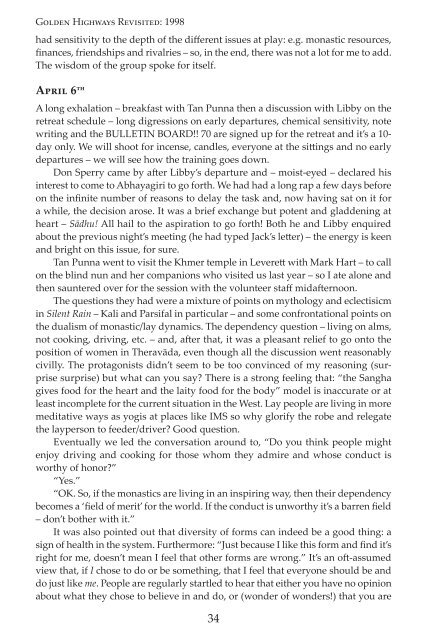Rugged Interdependency - Amaravati Buddhist Monastery
Rugged Interdependency - Amaravati Buddhist Monastery
Rugged Interdependency - Amaravati Buddhist Monastery
- No tags were found...
You also want an ePaper? Increase the reach of your titles
YUMPU automatically turns print PDFs into web optimized ePapers that Google loves.
Golden Highways Revisited: 1998had sensitivity to the depth of the different issues at play: e.g. monastic resources,finances, friendships and rivalries – so, in the end, there was not a lot for me to add.The wisdom of the group spoke for itself.April 6 thA long exhalation – breakfast with Tan Punna then a discussion with Libby on theretreat schedule – long digressions on early departures, chemical sensitivity, notewriting and the BULLETIN BOARD!! 70 are signed up for the retreat and it’s a 10-day only. We will shoot for incense, candles, everyone at the sittings and no earlydepartures – we will see how the training goes down.Don Sperry came by after Libby’s departure and – moist-eyed – declared hisinterest to come to Abhayagiri to go forth. We had had a long rap a few days beforeon the infinite number of reasons to delay the task and, now having sat on it fora while, the decision arose. It was a brief exchange but potent and gladdening atheart – Sādhu! All hail to the aspiration to go forth! Both he and Libby enquiredabout the previous night’s meeting (he had typed Jack’s letter) – the energy is keenand bright on this issue, for sure.Tan Punna went to visit the Khmer temple in Leverett with Mark Hart – to callon the blind nun and her companions who visited us last year – so I ate alone andthen sauntered over for the session with the volunteer staff midafternoon.The questions they had were a mixture of points on mythology and eclectisicmin Silent Rain – Kali and Parsifal in particular – and some confrontational points onthe dualism of monastic/lay dynamics. The dependency question – living on alms,not cooking, driving, etc. – and, after that, it was a pleasant relief to go onto theposition of women in Theravāda, even though all the discussion went reasonablycivilly. The protagonists didn’t seem to be too convinced of my reasoning (surprisesurprise) but what can you say? There is a strong feeling that: “the Sanghagives food for the heart and the laity food for the body” model is inaccurate or atleast incomplete for the current situation in the West. Lay people are living in moremeditative ways as yogis at places like IMS so why glorify the robe and relegatethe layperson to feeder/driver? Good question.Eventually we led the conversation around to, “Do you think people mightenjoy driving and cooking for those whom they admire and whose conduct isworthy of honor?”“Yes.”“OK. So, if the monastics are living in an inspiring way, then their dependencybecomes a ‘field of merit’ for the world. If the conduct is unworthy it’s a barren field– don’t bother with it.”It was also pointed out that diversity of forms can indeed be a good thing: asign of health in the system. Furthermore: “Just because I like this form and find it’sright for me, doesn’t mean I feel that other forms are wrong.” It’s an oft-assumedview that, if I chose to do or be something, that I feel that everyone should be anddo just like me. People are regularly startled to hear that either you have no opinionabout what they chose to believe in and do, or (wonder of wonders!) that you are34
















